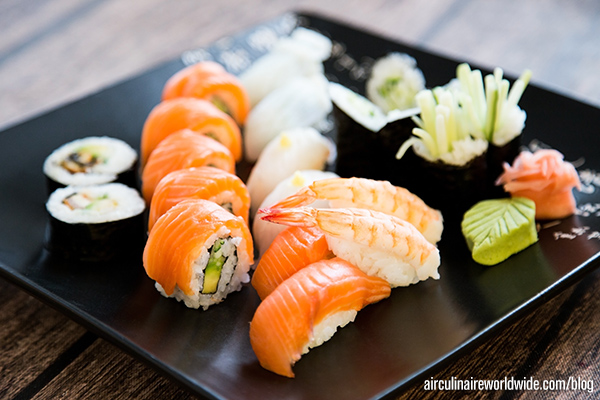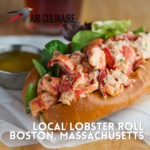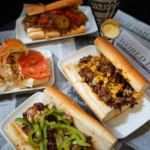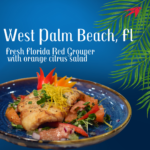What are High-Risk Foods?
Certain types of food can provide the ideal environment for bacteria to multiply in, and under the right conditions will support the multiplication of pathogens, hence the name “high-risk.” In really basic terms, these are foods that do not require any further cooking or process before consumption. If these foods are not stored or handled correctly, or come into contact with raw foods, and bacteria are given the opportunity to multiply, they can cause food poisoning. Common traits of high-risks food usually are that they are prepared ready-to-eat, protein-rich, require refrigeration, and most likely have a “use by” date.
High-Risk Food Examples
If we consider some of the items we individually order frequently for our inflight catering, it is fair to say the majority of them fall into the high-risk category: Cheeseboards, sandwich platters (especially those prepared with egg and mayonnaise), cold cuts, cold canapés, salads (in their component parts), sushi, sashimi, caviar, butter, cream and egg-based desserts – just to name a few. Examples also include:
- Cooked meat, sliced meats, antipasto, deli counter meats, pates.
- Meat pie and stocks used to make sauces and gravy.
- Milk, cream, cheeses, butter, margarine, soft cheese, custard, desserts containing dairy. e.g., tiramisu
- Eggs and products made from raw eggs. e.g., mayonnaise, salad dressing, mousse
- Shellfish, prawns, shrimps, lobster, oysters, crabs, etc.
- Cooked rice and cooked pasta
- Sushi and sashimi
Raw Ready-To-Eat Foods
There are certain types of raw foods that are not protein rich but have been implicated in food poisoning outbreaks due to being contaminated with viruses and the type of pathogens where only low numbers are required to cause illness. Examples of these raw foods are salads, fruit, root vegetables, berries, cut melon, prepared fruits and prepared vegetables. Soil, which many raw foods grow in or contact, can contain many pathogens. Fruit and vegetables should be kept chilled and double-washed in running water, once the skin of a fruit or vegetable is cut, we risk cross-contamination when the knife is pulled through from the skin to center. Treat these foods like high-risk foods!
Examples are:
- Bean sprouts (Contaminated beansprouts from Germany were implicated in a severe outbreak of E. Coli 0104 in Europe during 2011.)
- Sliced tomatoes
- Cut Melons
- Raspberries
- Spinach and lettuce (Bagged spinach was implicated in an E. Coli 0157 outbreak in the USA during 2006.)
Handling and Storage of High-Risk and Raw Ready-To-Eat Foods
The key to keeping high-risks food safe is the control of time and temperature and our handling of them. This is easier said than done when working on private aircraft where there is no chiller, limited galley space or when collecting food from outside sources. However, as food handlers, food safety is our responsibility.
As a food handler, ensure that:
- High-risk foods are protected from any possible contamination. They should be wrapped and separated. Do not accept unwrapped food items!
- High-risk / raw foods should kept refrigerated at 5 C (41 F) or less. This includes items collected from supermarkets, restaurants and hotels. Provision for chilled transportation must be made.
- Raw foods, including fruit, salads and vegetables should be kept chilled.
- Wash whole fruits thoroughly, double-wash where possible.
- Pre-sliced fruit and vegetables which will be consumed raw could be exposed to bacterial contamination, consider having whole items and slicing as required on long flights if possible, ensure to keep them wrapped.
- High-risk food and raw foods should be segregated to avoid cross-contamination.
- The flight attendant should wash their hands frequently during food handling. Especially when preparing high-risk foods, after touching raw foods, using the lavatory, touching the skin, hair or face; or when handling eggs or trash.
- If using food prep gloves, these must be changed frequently. Gloves are like a second skin, and become contaminated just as easily as hands can.
- Implement a good cleaning and disinfection procedure. The utensils, countertops and equipment should be disinfected and cleaned to avoid indirect contamination. Often the water onboard does not get hot enough to allow effective cleaning and disinfection to take place. Meaning some pathogens and food residues may be remaining on the utensils and surfaces!
- Be aware of your onboard condiments, dressings and sauces – some must be refrigerated after opening, as they then become high-risk (mayonnaise, quince paste, ketchup, etc.). Play it safe: if these are opened in-flight, throw them away at the end of the flight and replace unless you can keep them refrigerated on and off the aircraft.
Questions?
If you have any questions about this article, contact Yasmin Milner at ymilner@corporateflighttraining.com.
| This is an article by guest author Yasmin Milner of Corporate Flight Training. Yasmin is based in the United Kingdom and is an industry expert in corporate aviation. Any thoughts expressed in this article are entirely Yasmin’s and do not necessarily reflect the views of Air Culinaire Worldwide. |
If you would like to be considered for becoming a guest author, please contact socialmedia@airculinaire.com.





